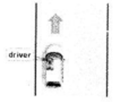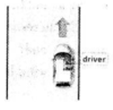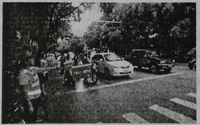| A.At a restaurant. | B.At an airport. | C.In an hotel. |
2 . There are two ways of driving in the world—if the driver’s seat is on the left and cars travel on the right side of the road, it is called “left-hand driving”, as it is in China, while the other way of driving is called “right-hand driving”, as it is in Britain. Nowadays, around 65% of the world’s population drives on the right of the road, while the rest is used to driving on the left.
Though no one knows the exact reasons, it seems likely that people in ancient times travelled on the left. Roman coins show pictures of horsemen passing on each other’s right. And right-hand people generally got on a horse from the animal’s left. Obviously, it’s safer to do this at the left side of the road, and it makes sense for the horse to be ridden on the left.
A change happened in the late 1700s. When Napoleon conquered nations, he forced them to travel on the right side of the road, which spread left-hand driving throughout Europe. However, Britain still stuck with the right-hand driving rule and countries which were part of the British Empire were made to follow. This is why India, Australia and the former British colonies in Africa continue to drive on the left. One exception is Egypt, as that country was defeated by Napoleon before becoming part of the British Empire.
Some countries changed sides until modern times. Sweden only moved to driving on the right in 1967 and Iceland changed the following year. Ghana changed sides in 1974. On September 7, 2009, Samoa became the third country ever to change from left-to-right-hand driving for the reason that it made it easier to import cheap cars from right-hand driving Japan, Australia and New Zealand.
So if you want to travel to another country or go on business, make sure you know whether it is left-hand or right-hand driving to avoid unnecessary troubles.
1. Which picture shows the correct driving in Britain?A. | B. | C. | D. |
| A.travelled on the right | B.behaved as they liked |
| C.got on the horses from the right | D.rode past each other’s right |
| A.Egypt | B.Australia | C.Sweden | D.China |
| A.To explain the advantages of the two ways of driving. |
| B.To compare the differences of the two ways of driving. |
| C.To complain about the change of the two ways of driving. |
| D.To introduce the development of the two ways of driving. |
3 . Hong Kong-Zhuhai-Macao Bridge will be the world's longest bridge over water when it
From an artificial island near Hong Kong International Airport, the structure
Engineers were faced with complex geological conditions and technical challenges. The building of the bridge combines the
4 . The Indian government may use 3D paintings as virtual speed-breakers on major highways and roads, in an attempt to check speeding and careless driving,and eventually make its deadly roads a little safer. “We are trying out 3D paintings used as virtual speed breakers to avoid unnecessary requirements of speed breakers,” India’s transport minister Nitin Gadkari tweeted.
The visual illusions (幻象) are supposed to encourage drivers to slow down automatically. Earlier this month, India had ordered the removal of all speed breakers from highways, which are considered to be a danger to safety for high-speed vehicles.
India has the highest number of road accident deaths in the world. According to the World Health Organisation, over 200,00 people are killed by road accidents due to poor application of road safety laws. This is considerably higher than its official figures of 141,526 for 2014.
The use of visual illusions as speed breakers was first pioneered in the American city of Philadelphia in 2008, as part of a campaign against speeding motorists. The technique has also been tried out in China to create floating 3D crossings.
In India, cities such as Ahmedabad and Chennai have already experimented with 3D zebra crossings in the last one year. In Ahmedabad for instance, two artists, mother and daughter have painted 3D crosswalks in the first few months of this year. The artists say their motto is “to increase the attention of drivers”, and that the concept has been successfully tested in zones where accidents easily occur on a highway.
However, critics argue that once drivers know that these speed breakers are visual illusions, they may ignore them. Others also point out that India’s decision does not consider the safety of a large number of walkers. In the end, the new policy may be just one step towards improving road safety.
1. According to the passage, 3D paintings as virtual speed breakers in India aims to .| A.Replace all speed breakers from highways. |
| B.Encourage essential requirements of speed breakers. |
| C.Check speeding and careless driving on all highways. |
| D.Remind divers to speed down voluntarily for road safety. |
| A.Speeding motorists. | B.Floating 3D crossings. |
| C.Free use of visual illusions. | D.Bad application of traffic laws. |
| A.giving examples. | B.analysing causes. |
| C.providing figures. | D.making comparisons. |
| A.subjective. | B.objective. |
| C.supportive. | D.critical. |
| A.A police officer. | B.A ticket seller. | C.A driver. |

要点如下:
1. 描述图片内容;
2. 你的感想。
注意:1. 同数:100左右,开头和结尾已为你写好,不计入总词数;
2. 适当增加细节,以使行文连贯。
3. 参考同汇:交通礼仪traffic etiquette。
Dear Editor,
This is a picture of a busy road.
____________________________________________________________________________________________
____________________________________________________________________________________________
____________________________________________________________________________________________
____________________________________________________________________________________________
____________________________________________________________________________________________
____________________________________________________________________________________________
______________________________________________________________
Yours sincerely,
Li Hua
建议理由:
1.便捷、准点;
2.舒适、安全;
3.购票方便、价格适宜。
注意:1.词数100左右;
2.可以适当增加细节,以使行文连贯;
3.开头和结尾已为你写好,不计入总词数。
参考词汇:中国高铁 CRH (China Railway High-speed);自助售票机 self-service ticket machine
Dear Peter,
I’m expecting you to come to China. _________________________________________________________
________________________________________________________________________________________________________________________________________________________________________________________
________________________________________________________________________________________________________________________________________________________________________________________
_________________________________________________________________________________________________________________________________________________________
Yours,
Li Hua
8 . Will there be a time in our lives when cars don’t crash? When we can just sit back and relax and our cars will drive themselves. Auto technology experts say “yes”. And they say that some of those advances may happen quicker than you might think.
They will require the users to input the name of the destination or the complete address of the location that they want to go and the cars’ artificial intelligence takes them there automatically without a driver. They will run on solar power in the daytime and ethanol fuel (乙醇燃料) at night. Toyota, BMW and Honda will completely control the trade of driverless car business together and will have the cheapest driverless cars. Fossil fuels will be completely incompatible (不相配的) with these cars.
Driverless cars will not require a driver’s license of any grade to operate. Anyone with basic literacy and computer skills who are at least 16 years of age will be legally allowed to operate the vehicle with absolutely no limits.This would give the young users permission to operate the driverless cars on major highways as well as secondary roads without needing a separate classification. In addition to all this, drunken people will be able to use their own automobiles to return home because they are not “driving”, the vehicle.
What’s more, car insurance will become obsolete(淘汰的) because there will be no more automobile accidents after the year 2025. This is because the driverless car will have all safety methods in place by the car’s artificial intelligence to prevent automobile accidents. Global positioning systems will become mandatory (强制的) in all newly-produced cars after 2010, and will be the most important part in the driverless car.
1. Who will not be able to use driverless cars?| A.Adults with basic literacy and computer skills. |
| B.Adults who are drunk. |
| C.Adults without a driver’s license. |
| D.Adults without computer skills. |
| A.will need fewer fossil fuels |
| B.will not need a human’s instructions |
| C.will run on solar power only |
| D.will be environmentally friendly |
| A.The people inside. |
| B.Global positioning systems. |
| C.Artificial intelligence. |
| D.Car insurance. |
| A.Car safety. |
| B.Driverless cars. |
| C.The future cars. |
| D.New technology in cars. |
9 . It is quite reasonable to blame traffic jams, the cost of gas and the great speed of modern life, but manners on the road are becoming horrible. Everybody knows that the nicest man would become fierce tigers behind the wheel. It is all right to have a tiger in a cage, but to have one in the driver's seat is another matter.
Road politeness is not only good manners, but good sense. It takes the most cool-hearted drivers great patience to give up the desire to beat back when forced to face rude driving. On the other hand, a little politeness goes a long way towards reducing the possibility of quarrelling and fighting. A friendly nod or a wave, or thanks in answer to an act of politeness helps to create an atmosphere of good will and becomes so necessary in modern traffic conditions. But suc h behaviors of politeness are by no means enough. Many drivers nowadays don't even seem able to recognize politeness when they see it.
h behaviors of politeness are by no means enough. Many drivers nowadays don't even seem able to recognize politeness when they see it.
However, misplaced politeness can also be dangerous. Typical example is the driver who waves to a child crossing the street at a wrong place into the path of oncoming cars that may not be able to stop in time. The same goes for encouraging old ladies to cross the road wherever and whenever they want to.
An experienced driver, whose manners are faultless, told me it would help if drivers learnt to correctly join in traffic stream without causing total jams that give rise to unpleasant feelings. Unfortunately, modern drivers can't even learn to drive, let alone master the roadmanship(驾车技能). Years ago, experts warned us that th e fast increase of the car ownership would demand more give-and-take from all road users. It is high time that all of us took this message to heart.
e fast increase of the car ownership would demand more give-and-take from all road users. It is high time that all of us took this message to heart.
| A.beat back when forced to face rude driving |
| B.be able to recognize politeness when he sees it |
| C.join in traffic stream quickly however other people feel |
| D.encourage children to cross the roads whenever they want to |
| A.great speed | B.traffic jams |
| C.terrible road conditions | D.the behaviors of the drivers |
| A.master roadmanship | B.create atmosphere of good will |
| C.encourage old ladies to cross the road | D.give a friendly nod to show politeness |
| A.Road Politeness | B.Traffic Jams |
| C.Good Manners | D.Modern Drivers |
10 . The past ages of man have all been carefully labeled by anthropologists(人类学家). Descriptions like “Paleolithic(旧石器时代) Man”, “Neolithic(新石器时代) Man”, etc., neatly sum up whole periods. When the time comes for anthropologists to turn their attention to the twenty-first century, they will surely choose the label “Legless Man”. Histories of the time will go something like this: “In the twenty-first century, people forgot how to use their legs. Men and women moved about in cars, buses and trains from a very early age. There were lifts in all large buildings to prevent people from walking. And the surprising thing is that they didn’t use their legs even when they went on holiday. They built cable railways, ski-lifts and roads to the top of every huge mountain. All the beauty spots on earth were ruined by the presence of large car parks.”
The future history books might also record that we lost the right of using our eyes. In our hurry to get from one place to another, we failed to see anything on the way. Air travel gives you a bird’s-eye view of the world or even less if the wing of the aircraft happens to get in your way. When you travel by car or train, the unclear picture of the countryside constantly slides over the window. When you mention the most impressive place-names in the world, the typical 21st century traveler always says “I’ve been there.”—meaning “I drove through it at 100 miles an hour on the way to somewhere else.”
When you travel at high speeds, the present means nothing: you live mainly in the future because you spend most of your time looking forward to arriving at some other place. But actual arrival, when it is achieved, is meaningless. You want to move on again. By traveling like this, you skip all experience. The traveler on foot, on the other hand, lives in the present. For him traveling and arriving are one and the same thing: he arrives somewhere with every step he makes. He experiences the present moment with his eyes, his ears and the whole of his body. At the end of his journey he feels a delicious physical tiredness. Satisfying sleep will be his: the just reward of all true travelers.
1. Anthropologists name man nowadays “Legless Man” because _________.| A.people prefer cars, buses and trains |
| B.people travel without using legs |
| C.lifts prevent people from walking |
| D.people use their legs less and less |
| A.The modern means of transportation. | B.A bird’s-eye view of the world. |
| C.The unclear sight from the vehicles. | D.The fast-paced life style. |
| A.appreciating beautiful scenery | B.experiencing life skills |
| C.focusing on the next destination | D.feeling physical tiredness |
| A.Modern transportation devices have replaced legs. |
| B.Traveling makes the world a small place. |
| C.Human’s history develops very fast. |
| D.The best way to travel is on foot. |



